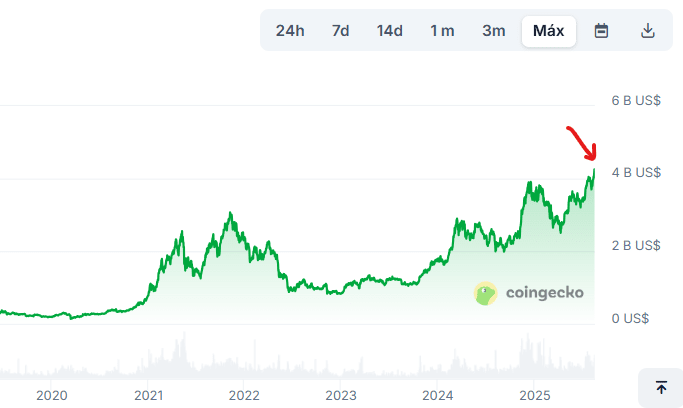In recent years, cryptocurrencies have ceased to be an experimental niche to become a market with trillions of dollars in total value. But what does that figure really mean? And how does it compare to more traditional markets like the US Stock Exchange or large global companies?
In this article, we explain what market capitalization (market cap) is, how it is calculated, and why it is so relevant to understanding the evolution and maturity of the crypto ecosystem.
What is market cap in cryptocurrencies?
The market capitalization of a cryptocurrency is calculated simply: current price of one unit × number of units in circulation.
Example: if a cryptocurrency is worth 10 dollars and there are 10 million in circulation, its market cap is 100 million dollars.
This calculation applies to both individual projects and the total value of all cryptocurrencies in the market, allowing for the measurement of the magnitude of the entire crypto ecosystem.
Beyond being just a number, market cap reflects the market's confidence in a project. Unlike the price per unit —which often misleads—, capitalization shows how much capital is actually invested.
That is why, when classifying a coin as large, medium, or small, the most reliable criterion is its market cap, not its individual price.
Historical evolution of crypto market cap
Since 2013, the market value of cryptocurrencies has grown explosively:
2013: barely a few billion dollars.
2017: with the rise of Initial Coin Offerings (ICOs), it surpassed 800 billion dollars, although a strong correction followed.
2020-2021: the market reached its historical peak, close to 3 trillion dollars, driven by institutional adoption, DeFi, NFTs, and greater integration with the financial system.
August 2025: the total value of all cryptocurrencies hovers around 4.08 trillion dollars, marking a phase of consolidation and technological expansion.

How does it compare with traditional markets?
Although 4.08 trillion dollars sounds like a colossal figure —and it is—, the crypto market remains small compared to other global sectors:
The New York Stock Exchange (NYSE + Nasdaq) exceeds 50 trillion dollars.
Companies like Apple or Microsoft have individual valuations close to 2 or 3 trillion, similar to the total market cap of the crypto market.
The gold market has a capitalization that is equivalent to about five or six times that of the crypto ecosystem.
Conclusion: despite the growth, there is still much room to continue scaling, especially if we consider the speed at which crypto technology integrates into the real world.
What composes that total value?
The majority of the capitalization is dominated by Bitcoin and Ethereum:
Bitcoin accounts for about 60% of the total and is considered a digital store of value.
Ethereum occupies second place, established as essential infrastructure for smart contracts and decentralized applications.
Together, they account for more than 70% of the total market cap.
The rest is composed of:
Altcoins like Solana, Polygon, Avalanche.
Stablecoins like USDT, USDC, DAI, which provide liquidity and stability.
DeFi projects, governance tokens, and utility assets, all part of a constantly evolving ecosystem.
Risks associated with market cap in crypto
Although it is a useful metric, market cap has its limitations:
Volatility can generate sharp losses in hours.
Projects with low liquidity can be easily manipulated.
In April 2025, for example, the Mantra token lost more than 90% of its value in less than an hour, revealing the risks in low-cap projects.
Additionally, some tokens may appear to be large just because they have inflated supply, even if they do not have real adoption or solid fundamentals.
That is why it is crucial to analyze other factors besides market cap: trading volume, liquidity, tokenomics, and the real utility of the project.
Why should you closely follow the total value?
Monitoring the total market cap of the ecosystem helps to understand the market moment:
When it is rising → there is an influx of capital, greater confidence, and a possible bullish cycle.
When it falls → it may reflect corrections, exit of speculators, or changes in risk appetite.
It is not just a number: market cap must be read in a macroeconomic context, along with factors such as:
Monetary policies.
Global inflation.
Institutional adoption.
Regulatory advances in Latin America and other markets.
Market cap is the thermometer of the crypto universe
With a current value of 4.08 trillion dollars, the total capitalization of the crypto market reflects an ecosystem that can no longer be ignored. Although it is still small compared to traditional markets, its sustained growth indicates that cryptocurrencies are consolidating as a new class of assets globally.
Understanding what market cap represents, how it is calculated, and how it evolves allows you to make more strategic decisions. Because it is not just a statistic: it is a signal of adoption, confidence, and technological transformation.
And you? Had you thought about the impact of market cap within the crypto ecosystem?
---
Image available on Freepik